11C![[double bond, length as m-dash]](https://www.rsc.org/images/entities/char_e001.gif) O bonds made easily for positron emission tomography radiopharmaceuticals
O bonds made easily for positron emission tomography radiopharmaceuticals
Abstract
The positron-emitting radionuclide carbon-11 (11C, t1/2 = 20.3 min) possesses the unique potential for radiolabeling of any biological, naturally occurring, or synthetic organic molecule for in vivo positron emission tomography (PET) imaging. Carbon-11 is most often incorporated into small molecules by methylation of alcohol, thiol, amine or carboxylic acid precursors using [11C]methyl iodide or [11C]methyl triflate (generated from [11C]carbon dioxide or [11C]methane). Consequently, small molecules that lack an easily substituted 11C-methyl group are often considered to have non-obvious strategies for radiolabeling and require a more customized approach. [11C]Carbon dioxide itself, [11C]carbon monoxide, [11C]cyanide, and [11C]phosgene represent alternative reactants to enable 11C-carbonylation. Methodologies developed for preparation of 11C-carbonyl groups have had a tremendous impact on the development of novel PET tracers and provided key tools for clinical research. 11C-Carbonyl radiopharmaceuticals based on labeled carboxylic acids, amides, carbamates and ureas now account for a substantial number of important imaging agents that have seen translation to higher species and clinical research of previously inaccessible targets, which is a testament to the creativity, utility and practicality of the underlying radiochemistry.
![Graphical abstract: 11C [[double bond, length as m-dash]] O bonds made easily for positron emission tomography radiopharmaceuticals](/en/Image/Get?imageInfo.ImageType=GA&imageInfo.ImageIdentifier.ManuscriptID=C6CS00310A&imageInfo.ImageIdentifier.Year=2016)

 Please wait while we load your content...
Please wait while we load your content...
![[double bond, length as m-dash]](https://www.rsc.org/images/entities/h2_char_e001.gif) O bonds made easily for positron emission tomography radiopharmaceuticals
O bonds made easily for positron emission tomography radiopharmaceuticals